Helvella lacunosa is a common mushroom most often sighted in summer and fall, but occasionally observed in mid-winter in California. The common name for this species is the ‘Black Elfin Saddle’ mushroom. This is the first time we’ve seen it here, but it’s quite well camouflaged in the woods, so much so that I almost walked right by it!
Its dark coloration makes this mushroom difficult to spot, and the convoluted cap gives it the appearance of some other dried up piece of forest-floor debris, making it easy to miss. However, on close inspection, this seemingly uninteresting mushroom is actually quite beautiful.
This mushroom is most commonly found growing under pine and fir, singly or in small clusters, and is widely distributed across North America, Europe, China and Japan. Helvella lacunosa is also often seen in woodland clearings growing on burnt ground. The cap typically ranges from 1-10 cm, and is most often grey or black, however, white forms are occasionally seen.
This is not a gilled mushroom, and close inspection under the saddle-shaped or convoluted cap reveals a thin, friable cap, the margin of which may be attached to the stem at several points forming small chambers.
The stem is perhaps the most intriguing part of the Elfin Black Saddle mushroom. Growing up to 15 cm in length, when young, the stem color may be more off-white in coloration, darkening with age to grey or black. The hallmark features of this mushroom are that the stem is ornately ribbed with pockets (lacunae), and is quite unlike most other mushrooms you are likely to encounter.
Some report Helvella lacunosa to be edible when cooked, although the stems are not eaten. Others report that Helvellas are indeed at least mildly toxic. Most mycologists however do not recommend its consumption. To the untrained eye, Helvella lacunosa is similar in appearance to some forms of Gyromitra esculenta which is a potentially deadly false morel mushroom. Certainly a mistake not worth making…


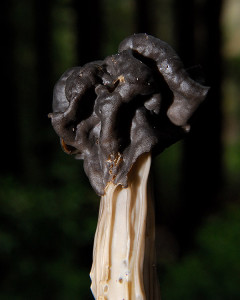
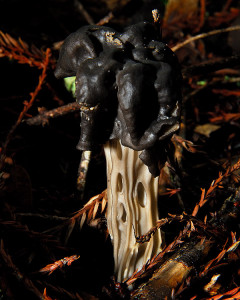
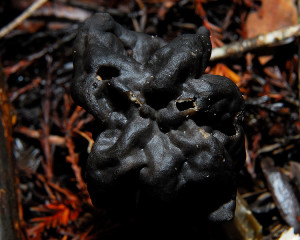
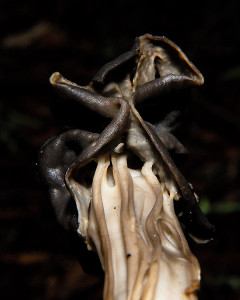
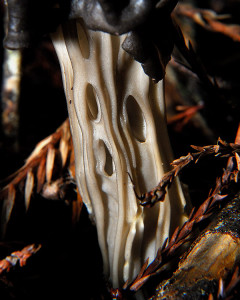







I so appreciate this mushroom feature, and I’m learning so much.
My husband comes from a decidedly mycophilic culture and wanted to learn the edible mushrooms of N. America as soon as he could, but I’m afraid after repeated forays into trying to learn, we’ve come to the conclusion that it will take us years of study before we can risk eating much. But still, they are fascinating things, even when not edible, and I can’t help but find them eerily beautiful.
Thank you so much for sharing. This week’s choice was extraordinarily otherworldly.
What an incredible looking mushroom this one is! In the last photo it looks like it is made of partly melted wax. I don’t think I would be tempted to give it a nibble 🙂
Dear CV, These mushrooms that you picture are, indeed, very strange in appearance.
I am so glad to have caught up with you again. Since the collapse of ‘Blotanical’ everything has been a little haywire and I only discovered this afternoon that you had posted when I found the advice email in my spam box. I really do not understand.
I love to eat Helvella lacunosa. I think they are better than morels.